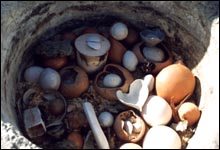
 |
|
Pots fired to cone 018 are placed upon a bed of sawdust. |
These photos came from a group pottery firing coordinated by
The firepit is dug out to four feet deep - all the material removed is neatly stacked so we can replace it later. We line the pit with eight inches of sawdust (from hardwood - the resin in softwood leaves undesirable marks on the piece [1]), then place the pots gently upon and in the sawdust. Where the pots are in contact with the sawdust they will become black, above the sawdust they will pick up colors from stuff in the next paragraph.
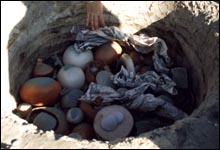 |
|
The pots are covered with newspaper to help start the fire. |
We sprinkle copper carbonate over and around the pots - it fumes in the fire to produce red and pink spots on the pots. Some people wrap copper wire (22 gauge or finer) around their pots - it leaves white or black lines, or does nothing, depending on the local temperature of the fire where the wire is. Fine steel wool placed near but not touching the pots produces pink blushes, banana peels (lots of potassium) can cause green. Get the idea? Toss stuff in to see what it does.
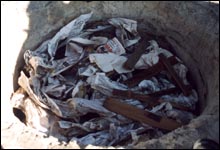 |
|
This is enough newspaper. |
The pots are covered with a thick layer of crumpled newspaper. The newspaper is there to help start the fire, it doesn't add to the coloration of the pots.
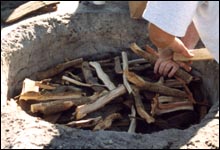 |
|
Completely dried oak kindling is placed on the newspaper. |
We stack on the wood, kindling first, then larger pieces. As for the sawdust we use only hardwood. The kindling in the photo is oak, the larger pieces are scrap from a furniture maker. Door makers are another good source of scrap hardwood. (Furniture/cabinet makers and door makers are also good source of sawdust - they have to pay to dispose of it, so you can save them money by taking it away).
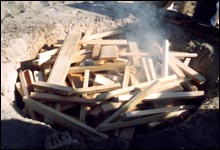 |
|
Hardwood scraps from a furniture maker go on top. |
The fire is started, then the pit is covered with some metal sheets. We cover the pits to keep the fire from burning too quickly - we want a slow burn over eight hours or so. The pots need to get hot enough to accept the colorants, and the fuming chemicals need time to deposit a noticeable amount of color - a fast fire would not let either happen. A fast fire is also stressful on the pots; we don't want to break them.
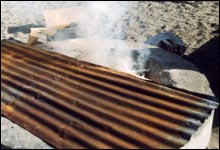 |
|
The pit is covered with corrugated metal sheets. |
After the fire has burned down, we uncover the pit. What we find is a bunch of dirty, smudged pots. The pots are cleaned with water and Bon Ami (a nonabrasive cleaning powder), then allowed to dry completely. They are then waxed - I use neutral shoe polish or beeswax, some people use Carnuba wax.
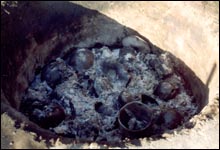
|
|
Eight hours later the pots are retrieved from the ashes. |
A variation of this process is called blackware firing
- dried cow dung is added to the fire,
then when the fire is nice and hot the whole thing is covered with ashes to keep air out of the fire.
Without access to air the pots turn completely black. I do both processes in one fire by making sealed
containers to contain both the pots and the cow dung.
[1] Some people paint designs on the pot with pine sap to take advantage of the mark resin leaves.
Return to the Gallery to see the results.